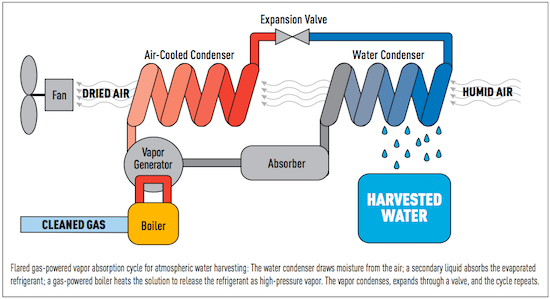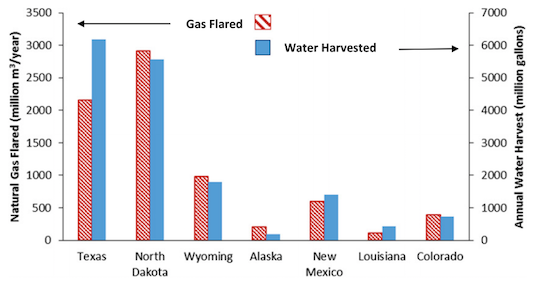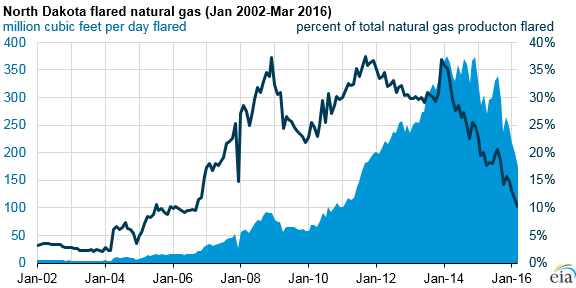This article was published in Scientific American’s former blog network and reflects the views of the author, not necessarily those of Scientific American
Back in March, I wrote about the huge amount of energy that is wasted in the form of natural gas flared or vented from oil and gas wells because there are no pipelines available, calling it the next great energy efficiency opportunity.
Fortunately, where there is wasted energy, there is an opportunity to utilize that energy for something useful. Now, a new method to do something useful with flared natural gas has emerged: harvesting water from the atmosphere so that it can be used to offset the huge amount of water required for hydraulic fracturing or “fracking.”
In a recent cover story for Mechanical Engineering magazine, University of Texas at Austin professor Vaibhav Bahadur introduced his method for pulling water from thin air using flared gas, and discussed how it could significantly offset some of the water demand from hydraulic fracturing.
On supporting science journalism
If you're enjoying this article, consider supporting our award-winning journalism by subscribing. By purchasing a subscription you are helping to ensure the future of impactful stories about the discoveries and ideas shaping our world today.
While the drilling of an average conventional oil or gas well requires about 250,000 gallons of freshwater, the hydraulic fracturing of a well requires about 2.5 million gallons per well — or ten times the volume — to create the huge pressure needed to crack underground shale formations and coax oil and gas from their pores. At the same time, a significant amount of hydraulic fracturing activity takes place in regions where water is scarce. About 48 percent of U.S. wells are located in extreme water stress areas, where more than 80 percent of available freshwater is already allocated for agriculture, electricity generation, and human consumption.
Bahadur and his team saw the huge amount of gas being flared from hydraulic fracturing wells in regions like Texas and North Dakota, and saw an opportunity to harvest water from the atmosphere using the heat released by flared natural gas in an absorption cooling process to condense humid air. An absorption cooler is essentially an air conditioner or refrigerator that runs on heat instead of electricity. It might sound like a thermodynamic fallacy, but absorption coolers are far from a new technology. Propane refrigerators that use an absorption cooling process are common today in RVs and other portable applications.

Bahadur and his team want to use an absorption cooling process to condense water from humid atmospheric air using flared gas. Cleaned natural gas that would otherwise be flared and wasted would be used to power an absorption cooler — or a heat-powered air conditioner — that cools down humid air to condense water from it. (Image from Bahadur, 2016.)
In a recent Environmental Research Letterspaper, Bahadur and his graduate student Enakshi Wikramanayake quantified just how much using their proposed atmospheric water harvesting technique could reduce the freshwater demand for hydraulic fracturing in various U.S. regions. They found that the volume of gas flared from Texas wells alone could harvest over 6 billion gallons of freshwater from the atmosphere annually — or over 16 million gallons per day. While these numbers represent the total water harvesting potential of using all the flared gas available, they calculated that even installing just one system at a Texas gas well could produce up to 30,000 gallons of water per day.

Bahadur and his graduate student calculated the amount of water that could be harvested from the atmosphere in various U.S. regions based on the amount of flared gas available and ambient weather conditions. (Image from Wikramanayake et al., 2016)
Bahadur’s research is important because new data from the U.S. Energy Information Administration show that the volume of natural gas flared or vented is still significant despite the low price of oil and the resulting slowdown in U.S. oil and gas drilling. While the amount of natural gas lost to flaring has declined significantly since 2015, there were still over 150 million cubic feet of gas flared per day in North Dakota alone in March 2016. That’s enough gas to harvest over 14 million gallons of freshwater per day using the method proposed by Bahadur.

While flaring has declined significantly in recent years, there is still enough natural gas flared in North Dakota alone to produce over 14 million gallons of freshwater per day using atmospheric water harvesting. (Image from U.S. Energy Information Administration, 2016.)
While Bahadur’s proposed method of atmospheric water harvesting has a lot of potential, it still hasn’t been tested in the field. However, there are many atmospheric water harvesting installations that run off electricity. To make their proposed technology a reality, Bahadur and his students will continue modeling the system in case studies to reveal the precise value proposition of the technology for oil and gas drillers. With delivered water costs as high as 15 cents per gallon in some regions, they hope that their system can deliver lower water costs thanks to its use of “free” energy in the form of flared natural gas. His research group also hopes to develop methods to make their absorption cooling system small enough to be deployed on a standard 18-wheeler truck, so that it can be quickly deployed to remote sites as needed.